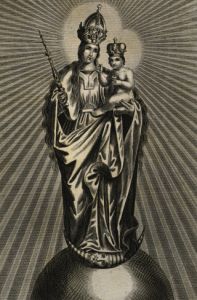Our Lady of Csiksomlyo
Our Lady of Csiksomlyo
Q: What is the significance of Our Lady of Csiksomlyo?
A: Csiksomlyo (in Rumanian Sumuleu, Sumleu, a place near Miercurea Ciu, Rumania) in Hungary before 1921 is the most important place of pilgrimage for the Roman Catholic Hungarians living in Transylvania.

The pilgrimage site is comprised of a Franciscan monastery church, a Way of the Cross, the Anthony Chapel and the so-called Savior Chapel, located on the nearby Kissomlyo Hill (seleu-mic in Rumanian). The first establishment of the Franciscans there is attested to around the year 1400. Around 1441-1442 Janos Hunyadi, as a memorial of his victory over the Turks, established thirty-two monks there to construct a new building and to enlarge the cloister and the church. Pope Eugene IV in 1444 granted the church an indulgence for the Feast of the Visitation. The frequently destroyed, renewed and enlarged church was torn down in 1802, the crypt alone remaining. Between 1804 and 1835 a substantial new church was built. The furnishings of the new church are all of the nineteenth century with the exception of the statue honored there. Until the present time the place has been under the care of the Franciscans.
The focus of the cult there is a late-Gothic wooden statue of the Virgin Mary, over two meters tall, which stands on a pedestal above the high altar. Mary stands in the sun, holding the Child Jesus and a scepter. It is presumably the work of a Hungarian wood-carving center from the sixteenth century. The miraculous character of the statue was the object of several episcopal investigations during the eighteenth century. On September 20, 1798 it was officially declared a wonderworking image and was crowned.
The beginning of the pilgrimage, which is still alive today, goes back to Pentecost of 1567. At the time the Hungariana king (a non-Catholic), Zsigmond Janos (1540-1571) with his Protestant army attacked the Catholics assembled for what amounted to a congress to force them to abandon their faith; however, he suffered a defeat, which was ascribed to the help of the Virgin Mary. The pilgrimage has been revived several times; as for example, after 1661, when Turkish-Tartar troops ravaged the territory, though the statue itself was rescued. The site was much loved during the ninteenth century. Between twenty and thirty thousand faithful went together there for the Feast of Pentecost. During the four hundred years of its existence, the pilgrimage center has served as a meeting place for the so-called Csango-Hungarians who had settled in Moldavia and for the Catholic Hungarians in Transylvania for whom it is also an important spiritual and cultural center. The place has an important role in the preservation of their national identity.
All About Mary includes a variety of content, much of which reflects the expertise, interpretations and opinions of the individual authors and not necessarily of the Marian Library or the University of Dayton. Please share feedback or suggestions with marianlibrary@udayton.edu.
